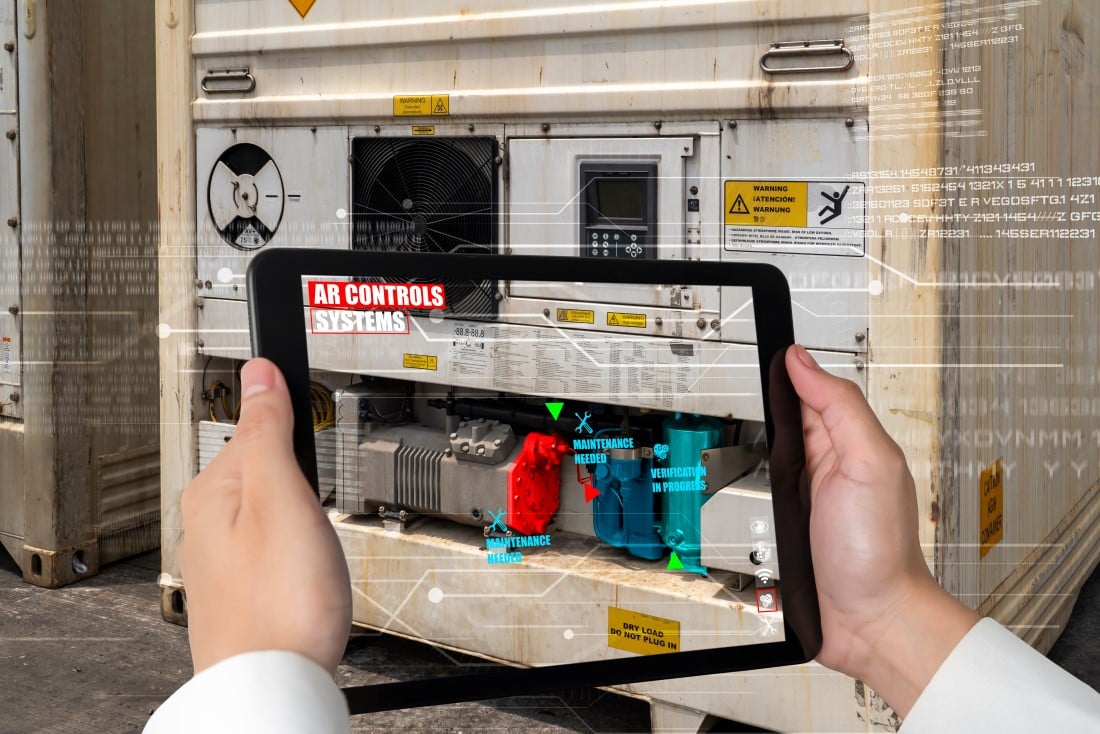What is Knowledge Management and Why is it Important?
Knowledge Management is a phrase that gets thrown around haphazardly, but there is often confusion regarding its meaning, goals and benefits. This...

Augmented Reality is increasingly being adopted across the field service industry. With customers demanding better remote self-service options, and field service organizations focused on improving the customer experience as well as addressing the increased demand for innovative services, Augmented Reality offers solutions that can resolve a variety of challenges.
Augmented Reality is an interactive experience that enhances a real world environment by superimposing computer-generated 3D elements into the existing environment all in real-time. While Augmented Reality is often confused with Virtual Reality (VR), they are quite different. For instance, Virtual Reality is a self-contained computer environment completely separate from the real world environment, while Augmented Reality adds digital elements to enhance the existing real world.
There are three types of Augmented Reality: marker-based, markerless, and location-based. While each type relies on computer technology, they require different approaches to user interaction. For example, marker-based Augmented Reality must first recognize unique visual points before populating an animation, and the element will appear to “stick” to the marker. Markerless Augmented Reality allows users to move a virtual object anywhere in their real world environment, and will typically appear to “float” in mid-air. Location based Augmented Reality ties digital content to a specific location in the real world environment, and leveraged in tandem with GPS, it can accurately explain location-based information or add elements to specific surroundings.
With innovative applications for Augmented Reality in a myriad of industries, it’s no surprise that Augmented Reality is also making a splash in the field services industry. Brian Blau, the former Gartner Research Vice President, explains that Augmented Reality can be used in two main ways in field service. First, it can be used as an interactive visual aid for field technicians by superimposing detailed diagrams and instructions over equipment in the field. In addition, it can be used as a visually focused remote tool for customers, allowing them to collaborate virtually with expert technicians while enabling a “see-what-I-see” approach. In both cases, Augmented Reality can be used to provide information enablement in the field, all in real-time.
Research estimates that the global market for Augmented Reality is projected to reach a compound annual growth rate of 48.6% over the next several years. In other words, the Augmented Reality market is expected to increase to almost $98 billion by 2028, in comparison to only $4.2 billion in 2020. This optimistic outlook illustrates that the Augmented Reality market is here to stay, and with wider adoption, Augmented Reality could very well be the future of the field services. Along with other innovative service workflows fueled by technological advancements, such as IoT-driven predictive maintenance, the adoption of Augmented Reality has the potential to dramatically transform the way field service companies provide services to and interact with their customers.
Field service companies have every reason to join the digital transformation and start investing in cutting edge field service technology. By incorporating powerful technology like IoT and Augmented Reality into their existing technology stack, they can build a flexible, intelligent, and informative service environment that fuels data-driven decision making.
Let’s dive into five specific ways that Augmented Reality can benefit field service companies.
1. Customer ExperienceWithout field service technology, customers are relegated to manual service experiences that rely heavily on inefficient service workflows often riddled with human errors. This includes back-and-forth phone communication regarding service appointments, technicians arriving late and/or ill-prepared for the specific challenges of the job at hand, and a high probability of a repeat service visit to resolve the same issue. Without any control over or understanding of what’s happening with the service workflow, the customer is left to endure the brunt of the frustration that is caused by honest but preventable mistakes throughout their service experience.
To this extent, customers are craving more convenient service experiences, and also more control over their experiences. Thankfully, Augmented Reality can help make both of these desires a reality. By enabling comprehensive and intuitive remote support options, Augmented Reality increases the convenience of service jobs, especially during inopportune timelines. This control is a significant benefit for customers, and research shows that “the use of Augmented Reality and related technologies will become the standard by which customers evaluate and measure field service performance.” In addition, Augmented Reality can make service experiences more convenient by reducing service resolution times and improving first-time fix-rates. In fact, field service organizations using Augmented Reality and remote support tools can experience a 20% to 30% improvement in core customer KPIs like customer satisfaction rates and first call resolution.
Get the eBook: Leverage AR and Remote Support in Your Field Service Organization
2. Remote Triage and TroubleshootingTraditionally, field service technicians have been forced to approach service troubleshooting with limited information about the specific issue at hand. Without all of the necessary details to troubleshoot a repair or maintenance job, they are not set up to successfully resolve an issue on their first-try. This is especially true of less experienced technicians that rely more heavily on a customer’s input regarding the details of the job. The inverse is also true, as customers have to rely on the field service technician’s descriptions of what could be the issue, there is a higher likelihood of needing a technician to come in person to resolve the issue themselves.
Augmented Reality technology eliminates this game of “telephone” between customers and technicians. By providing a visual approach to remote triage and troubleshooting, neither side has to rely solely on the other’s word, because they can see the issue for themselves. With remote triage technology powered by Augmented Reality, technicians can see exactly what the customer is seeing, and they can better understand the space and layout of the product at hand. In addition, technicians can communicate with customers visually, employing Augmented Reality pointers and markers to highlight specific parts of the equipment or system. This is no small feat, in fact, Augmented Reality triage and troubleshooting can reduce in-home visits by up to 42%.
3. Virtual Collaboration & Self-Guided RevolutionField service companies using manual service workflows have been especially vulnerable to the significant shortage of skilled workers in the field service industry. This workforce shortage has been fueled by three main factors: service demand increasing, older technicians retiring, and fewer workers entering the industry. As this shortage is projected to worsen over time, the impact on the industry will take a toll. Without an adequate number of experienced technicians to complete service jobs, it is difficult to keep up with demand from both current and potential customers. By missing out on opportunities for new clientele, and providing rushed or novice service to existing customers, companies are set out on an unsustainable and ultimately unsuccessful path.
Adopting Augmented Reality-powered technology can help field service companies tackle the workforce shortage and the numerous shortcomings of an understaffed business. With an Augmented Reality-enabled mobile device, less experienced technicians are empowered to provide high-quality service for customers. By visually collaborating with a remote expert, they can receive real-time step-by-step guidance throughout the entire service process. Likewise, novice technicians can also rely on Augmented Reality technology to visually represent computer-generated product information such as service manuals, diagrams, temperature and pressure reading, part numbers, and descriptions. Used in tandem with IoT devices, technicians can access detailed service information that reduces time spent on troubleshooting. In addition, experienced technicians can easily record their Augmented Reality sessions for new techs to use for training purposes. By enabling technicians to access this helpful and actionable information, field service companies can augment the skills and productivity of the existing workforce to make up for the shortage in skilled workers.
4. Remote Workforce ManagementWorkforce management has historically been reliant on manual techniques for onboarding and training service technicians. While onboarding and training are critical aspects of workforce management that should not be overlooked, inefficient manual methods of onboarding and training should be. Spending considerable amounts of time onboarding and training new technicians takes away from time spent servicing customers, and can also rack up substantial expenses along the way. As the expression goes, “work smarter, not harder.” And that’s where Augmented Reality technology comes in- making field service workforce management significantly smarter.
Augmented Reality powered field service technology provides comprehensive technician training anywhere, at any time. By combining information enablement with time and location flexibility, Augmented Reality streamlines the complex training process while also making it accessible to a wider range of workers. Augmented Reality also allows technicians to access incredibly useful virtual tools in real-time, such as laser pointers, electronic markers, optical character recognition (OCR), location tracking, and automatic call logging. All of this enables field service companies to build and manage a skilled technician workforce quickly and at a lower cost. For example, Lockheed Martin was able to reduce engineer training time by 60% and increase proficiency by 50% to 70% using Augmented Reality technology.
5. Warranty ManagementWarranties are widely accepted as a key factor for generating additional revenue within the field service industry. In fact, 93% of warranty professionals say that warranty chain management is “very important” or “extremely important” to overall financial performance of the business. With so much at stake, there is little room to negatively impact warranty performance. Likewise, higher levels of warranty performance have been linked to improving customer retention and demand, with 77% of warranty professionals citing them as top drivers. This means that field service companies need to pay extra attention to their customer relationships if they plan on optimizing their warranty performance and generating extra revenue.
With Augmented Reality technology, field service organizations can encourage technicians to upsell warranties and increase profitability. For instance, by allowing technicians to access and review customer’s existing warranties in real-time, they can assess opportunities for upselling. In addition, this real-time information allows technicians to quickly spot customers that do not currently have any warranties at all, which is a pivotal moment for improving warranty performance. At the end of the day, improving warranty performance should be a priority for all revenue obsessed field service companies.
ServicePower helps field service organizations reap the numerous benefits of the digital transformation by providing the technology they need to supply innovative, efficient, and profitable solutions for their customers. Purpose built for employed, contracted, and blended workforces, ServicePower’s IoT and Augmented Reality powered remote service and support platforms are a perfect match for field service companies that care about flexibility, innovation, and ultimately, profitability. In fact, in 2020 Gartner recognized ServicePower for increasing the time it takes to achieve ROI.
Experience ServicePower’s Augmented Reality powered platform for yourself with a custom demo.

Knowledge Management is a phrase that gets thrown around haphazardly, but there is often confusion regarding its meaning, goals and benefits. This...

The field service industry is rapidly changing as the digital transformation renders manual field service processes and workflows obsolete. Staying...

As a field service leader looking to embrace digital transformation and leverage Data-Driven Decision Making, investing in the right software is...